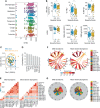Sustained Antibody-Dependent NK Cell Functions in Mild COVID-19 Outpatients During Convalescence
- PMID: 35197972
- PMCID: PMC8859986
- DOI: 10.3389/fimmu.2022.796481
Sustained Antibody-Dependent NK Cell Functions in Mild COVID-19 Outpatients During Convalescence
Abstract
The coronavirus disease 2019 (COVID19) pandemic has left researchers scrambling to identify the humoral immune correlates of protection from COVID-19. To date, the antibody mediated correlates of virus neutralization have been extensively studied. However, the extent that non-neutralizing functions contribute to anti-viral responses are ill defined. In this study, we profiled the anti-spike antibody subtype/subclass responses, along with neutralization and antibody-dependent natural killer cell functions in 83 blood samples collected between 4 and 201 days post-symptoms onset from a cohort of COVID-19 outpatients. We observed heterogeneous humoral responses against the acute respiratory syndrome coronavirus 2 (SARS-CoV-2) spike protein. Overall, anti-spike profiles were characterized by a rapid rise of IgA and sustained IgG titers. In addition, strong antibody-mediated natural killer effector responses correlated with milder disease and being female. While higher neutralization profiles were observed in males along with increased severity. These results give an insight into the underlying function of antibodies beyond neutralization and suggest that antibody-mediated natural killer cell activity is a key function of the humoral response against the SARS-CoV-2 spike protein.
Keywords: COVID-19; Fc-effector functions; NK cells activity; SARS-CoV-2; outpatients; spike (S) glycoprotein.
Copyright © 2022 Fuentes-Villalobos, Garrido, Medina, Zambrano, Ross, Bravo, Gaete-Argel, Oyarzún-Arrau, Amanat, Soto-Rifo, Valiente-Echeverría, Ocampo, Esveile, Ferreira, Cabrera, Torres, Rioseco, Riquelme, Barría, Alvarez, Pinos, Krammer, Calvo, Barria and COVID-19 South Chile Group.
Conflict of interest statement
Authors JLG and RA were employed by company Ichor Biologics LLC. JLG and RA were partially supported by Ichor Biologics LLC. The remaining authors declare that the research was conducted in the absence of any commercial or financial relationships that could be construed as a potential conflict of interest.
Figures





References
Publication types
MeSH terms
Substances
Grants and funding
LinkOut - more resources
Full Text Sources
Medical
Miscellaneous

